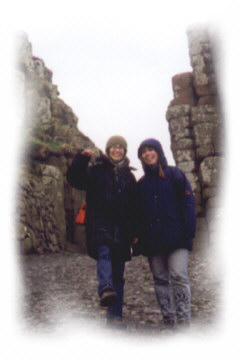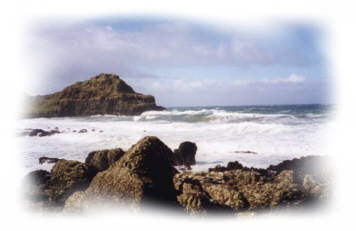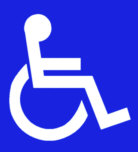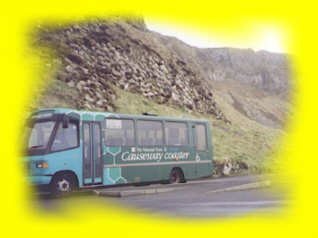The Giant's Causeway is one of Ireland's biggest natural attractions. It consists of a coastal section which, in addidtion to its extreme ruggedness, displays many peculiar rock columns that almost look as though they've been fabricated by humans rather than nature. This geological phenomenon came about, as molten rocks (lava) were cooling off. According to a legend, however, the Giant's Causeway was created by Giant Finn McCool as he wanted to travel over to Scotland without getting wet feet. Hence the name. The Giant's Causeway is a National Trust property. Wheelchair access used to be excellent, but right now things are rather uncertain, because the award-winning, completely accessible Visitors Centre was destroyed by a fire in April 2000.
|
|
|
This is a view from the visitors centre to the driveway leading down to the actual Giant's Causeway which is situated further down, behind that ridge around which the driveway wraps itself. It doesn't look like it on the picture, but the driveway is quite steep. There is a bus taking people down and back up every 15 minutes, for which there is a small charge. Private cars aren't allowed on this road as it is reserved to pedestrians and National Trust vehicles. |
|
|
A few notes on the region Having stayed in the coastal regions of Northern Ireland for little more than one day, all I dare to say is that this is way too little time to explore all the region's outstandingly beautiful natural and cultural sights. Our travel route along the northern coast touched a number of very beautiful resorts. Many have paved promenades, and at least the larger towns all seem to have facilities for the disabled. We also visited Londonderry's inner city (town walls partly
accessible through ramps) which is nice, but very steep with
narrow streets and therefore a bit difficult for wheelchair users to
get around. The tourist brochure did not contain any information on disabled access. There didn't seem to be that many disabled parking spaces either. After being misguided by a stupidly-placed sign apparently pointing to a closed car-park, I found an accessible loo in that shopping center containing the Marks & Spencer department store. Might not be open 24 hours a day, but was open on Sunday. Conclusion: Looks like the city could use some improvements in accessibility for the disabled. It may well be, though, that there still exist more urgent problems to solve in this city. For an in-depth discussion of the "Bloody Sunday" event taking place in Londonderry and its significance for the conflict in Northern Ireland, I suggest visiting the CAIN Project Website.
Links
|
Considering the rugged environment, disabled
access to this major tourist destination is very
good indeed. I was both surprised and impressed.
The visitors centre and the adjacent parking lot is
completely accessible to wheelchair users. There's
a couple of ramps inside and outside which might
be a bit steep for people with limited armpower,
but there'll always be someone around to give a
hand. Fully accessible loo; the key is to be
obtained from the centre's main souvenir counter. Down on the coastal level, there is one footpath along the coastline which wheelchair folks can use for the first 200 meters or so until it bends and goes straight uphill. Except for the paved driveway, all other trails are pretty much impossible, including the one leading from the visitor's centre to the nearby clifftop. The driveway itself looks manageable for manual wheelchairs, also in its steep upper part. It will give you quite a nice workout! BAD NEWS!
According to the accommodation guide for the
Antrim Coast & Glens, there are several other
places suitable for wheelchairs in the area. The
brochure is called "Where To Stay" and can be
obtained at any Tourist Information Center in
Northern Ireland. Take my advice and try the
Valley View B&B first! Between 1968 and 1998, 3,500 people were killed in the Northern Ireland conflict, and the violence hasn't fully stopped yet. The people of Northern Irleand both need and deserve all the support they can get to put an end to the "troubles" and bring lasting peace to this otherwise so beautiful region of Europe. |
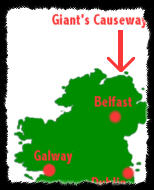
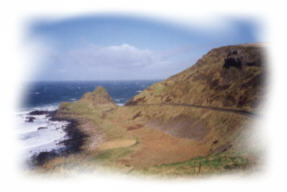
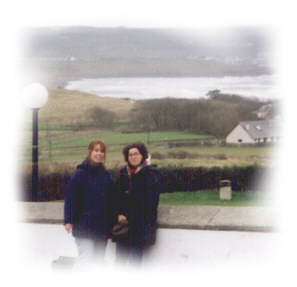 My charming
travel mates Giulia and Claudia, standing at the visitors centre (left)
and being framed by some of the basalt columns (right) of wich the
Giant's Causeway consists.
My charming
travel mates Giulia and Claudia, standing at the visitors centre (left)
and being framed by some of the basalt columns (right) of wich the
Giant's Causeway consists. 